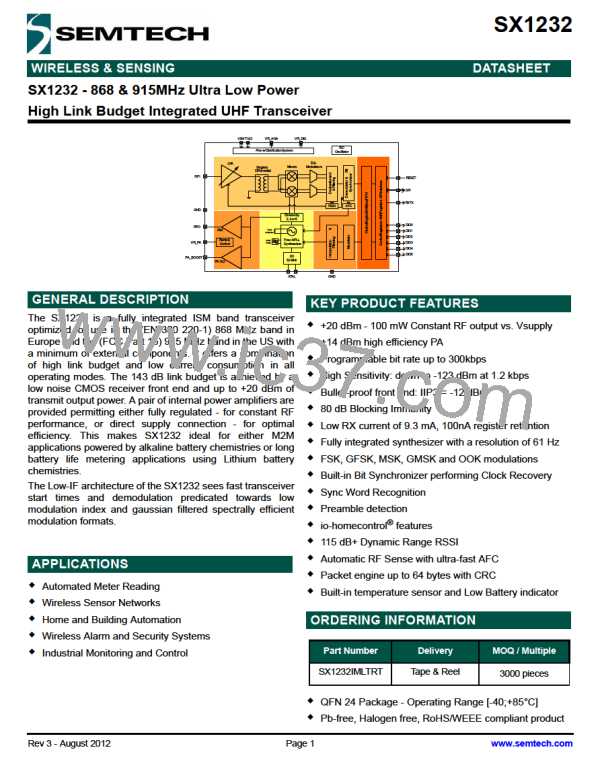SX1232
WIRELESS & SENSING
DATASHEET
3.4. Transmitter Description
The transmitter of SX1232 comprises the frequency synthesizer, modulator and power amplifier blocks, together with the
DC biasing and ramping functionality that is provided through the VR_PA block.
3.4.1. Architecture Description
The architecture of the RF front end is shown in the following diagram. Here we see that the unregulated PA0 is connected
to the RFO pin features a single low power amplifier device. The PA_BOOST pin is connected to the internally regulated
PA1 and PA2 circuits. Here PA2 is a high power amplifier that permits continuous operation up to +17 dBm and duty cycled
operation up to +20 dBm. For full details of operation at +20 dBm please consult Section 3.4.7.
LNA
ReceiverChain
RFI
PA 0
RFO
Local
Oscillator
PA 1
PA 2
PA _BOOST
Figure 7. RF Front-end Architecture Shows the Internal PA Configuration.
3.4.2. Bit Rate Setting
The bitrate setting is referenced to the crystal oscillator and provides a precise means of setting the bit (or equivalently
chip) rate of the radio. In continuous transmit mode (Section 3.2.2) the data stream to be transmitted can be input directly
to the modulator via pin 9 (DIO2/DATA) in an asynchronous manner, unless Gaussian filtering is used, in which case the
DCLK signal on pin 10 (DIO1/DCLK) is used to synchronize the data stream. See section 3.4.5 for details on the Gaussian
filter.
In Packet mode or in Continuous mode with Gaussian filtering enabled, the Bit Rate (BR) is controlled by bits Bitrate in
RegBitrateMsb and RegBitrateLsb
FXOSC
------------------------------------------------------------------------
BitRate =
BitrateFrac
-------------------------------
BitRate(15,0) +
16
Note BitrateFrac bits have no effect (i.e may be considered equal to 0) in OOK modulation mode
The quantity BitrateFrac is hence designed to allow very high precision (max. 250 ppm calculation error) for any bitrate in
the programmable range. Table 9 below shows a range of standard bitrates and the accuracy to within which they may be
reached.
Rev 3 - August 2012
Page 22
www.semtech.com

 SEMTECH [ SEMTECH CORPORATION ]
SEMTECH [ SEMTECH CORPORATION ]